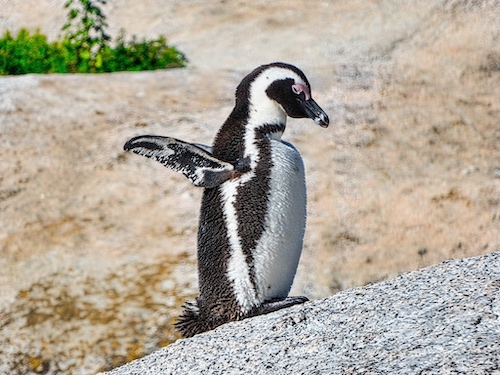
The Boulders Beach African Penguin Colony was established in 1982 by a breeding pair of penguins who settled near Capetown, South Africa after fleeing when a larger colony was devastated. Today there are currently 28 African penguin colonies, only four of these occurring on the African mainland. These colonies run along the coast, from Algoa Bay in South Africa to Namibia’s Penguin Islands. Despite the huge distances between these colonies, it is not uncommon for young penguins to visit, and occasionally resettle, at a different colony from which they hatched. African penguins are clearly resilient animals. They have evolved the behavioral mechanisms to move their entire population to deal with changes in the abundance of food. Despite their wide range and versatile juveniles, African penguin numbers are declining fast – so fast that it is believed they will be extinct within 10 years. Today there are fewer than 21 000 pairs of African penguins left in the wild – 100 years ago there were single colonies that had over a million, like Yzerfontein’s Dassen Island. Dassen Island is, unfortunately, not a unique case. The total breeding population across both South Africa and Namibia fell to a historic low of about 20,850 pairs in 2019. Quite simply, our common seafoods – sardines, anchovies and pilchards – are the products directly linked to the decline in penguin numbers. You may have been unaware, but sardines/pilchards have recently been added to the WWF SASSI Orange List – a seafood you should avoid. These ratings do not only mean that the fish itself is at risk, but also that the practices used to catch it are harmful to other species. I would go a step further in saying seafood of any kind should only be consumed if it is sustainably farmed. Bottom trawling destroys far more ocean habitat than any other fishing practice. In this common fishing method, large weighted nets are dragged across the ocean floor, clear-cutting a swath of habitat in their wake. Some of these scars will take centuries to heal, if ever.
Boulders Beach
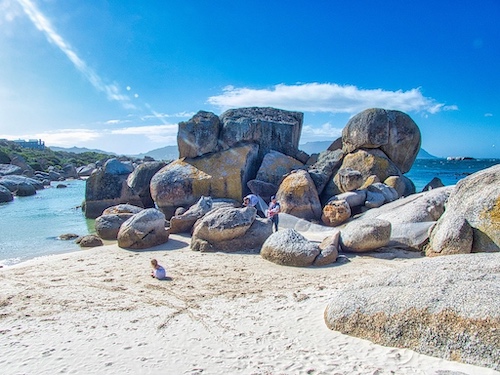
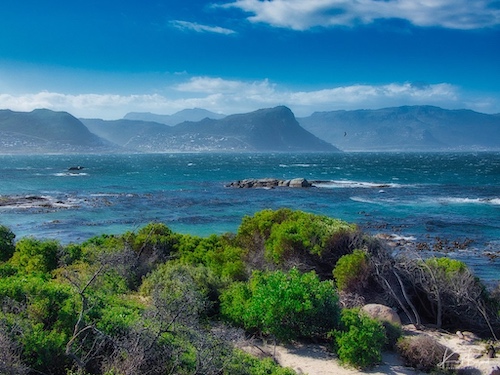
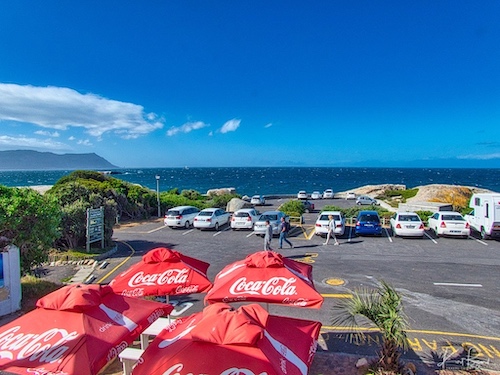
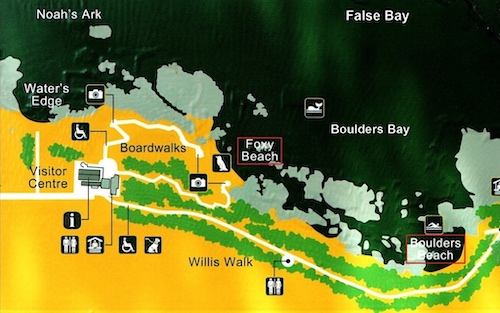
Boulders Beach is a sheltered beach made up of inlets between granite boulders, from which the name originated. It is located in the Cape Peninsula, near Simon’s Town towards Cape Point, near Cape Town in the Western Cape province of South Africa. It is also commonly known as Boulders Bay. It is a popular tourist spot because of the colony of African penguins which settled there in 1982. Boulders Beach forms part of the Table Mountain National Park. These African penguins are only found on the coastlines of Southern Africa, specifically South Africa and Namibia. These penguins are currently on the verge of extinction. As a result, the penguins are under the protection of the Cape Nature Conservation. Although set in the midst of a residential area, it is one of the few sites where this vulnerable Cape Penguin (Spheniscus demersus) can be observed at close range, wandering freely in a protected natural environment. From just two breeding pairs in 1982, the penguin colony has grown to about 3,000 birds in recent years. To see the penguins, you ’don’t actually walk on the beach. They have a visitors center that sells tickets and you walk on elevated walkways to see the penguins.
Cape Rock Hyrax
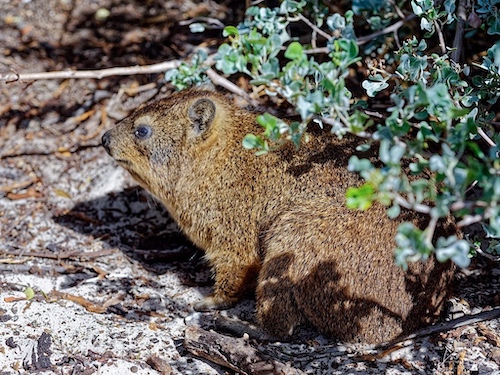
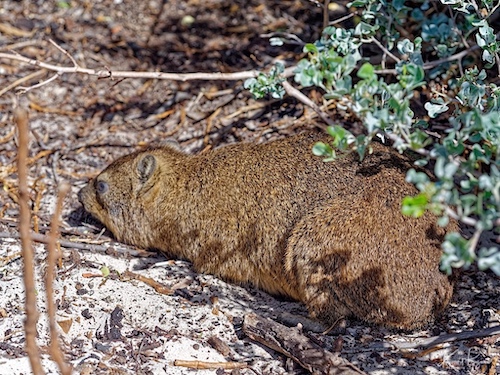
I saw this interesting little creature in the bushes on the side of the Willis path to the beach. The Rock Hyrax (Procavia capensis), also called Cape Hyrax, Rock Rabbit, and (in the Bible) Coney, is a medium-sized mammal native to Africa and the Middle East. Commonly referred to in South Africa as the Dassie (Afrikaans: klipdassie), it is one of the five living species of the order Hyracoidea, and the only one in the genus Procavia. Rock hyraxes weigh between 9–11 pounds (4–5 kg) and have short ears and tail. Prominent in and apparently unique to hyraxes is the dorsal gland (just behind the eyes), which excretes an odor used for social communication and territorial marking. Along with other hyrax species and the sirenians, this species is the most closely related to the elephant. The rock hyrax has a prominent pair of long, pointed tusk-like upper incisors which are reminiscent of the elephant, to which the hyrax is distantly related. The rock hyrax occurs across sub-Saharan Africa, with the exception of the Congo Basin and Madagascar. The distribution encompasses southern Algeria, Libya, Egypt and the Middle East, with populations in Palestine, Israel, Jordan, Lebanon and the Arabian Peninsula. The shade of their pelt varies individually and regionally. In particular the dorsal gland patches (present in both sexes) of the central populations are very variable, ranging from yellow to black, or flecked. There are 5 subspecies, differing in the dorsal gland patches, black in P. c. capensis, cream in P. c. welwitschii, and orange in P. c. ruficeps.
African Penguins
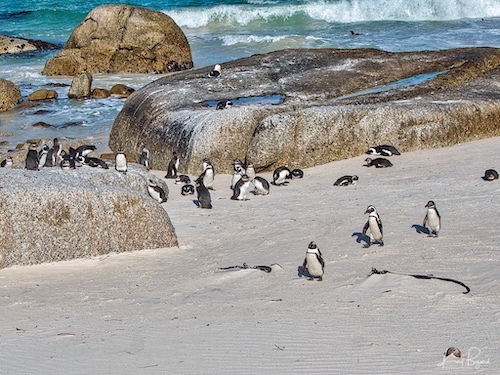
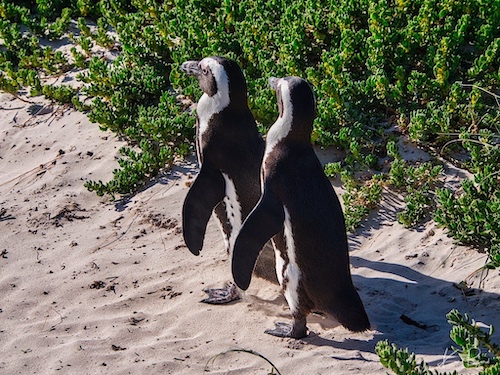
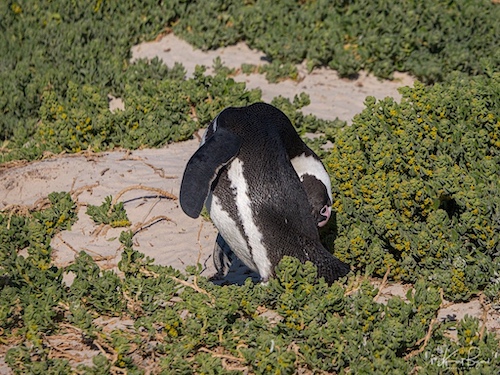
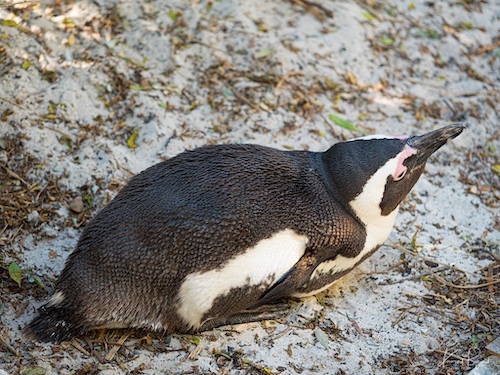
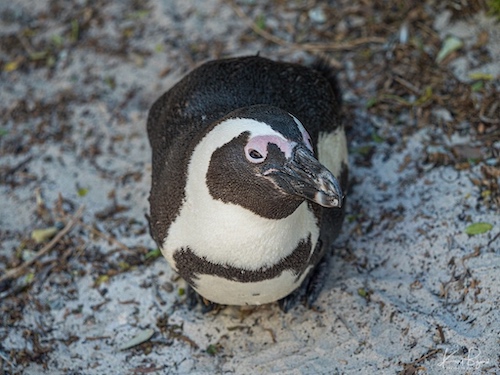
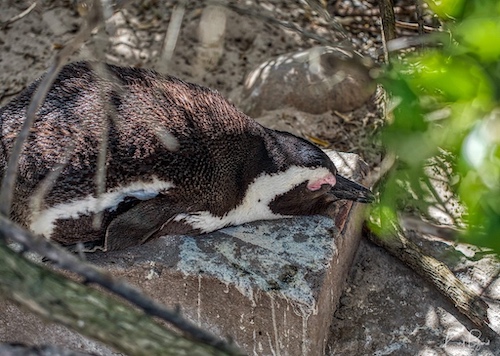
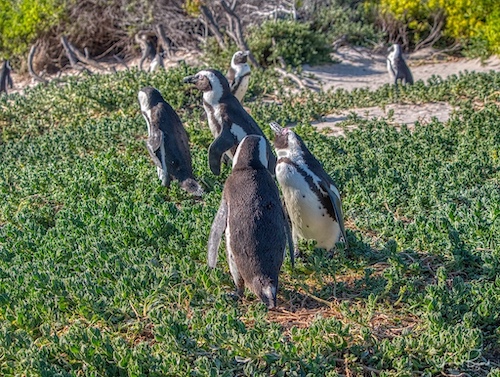
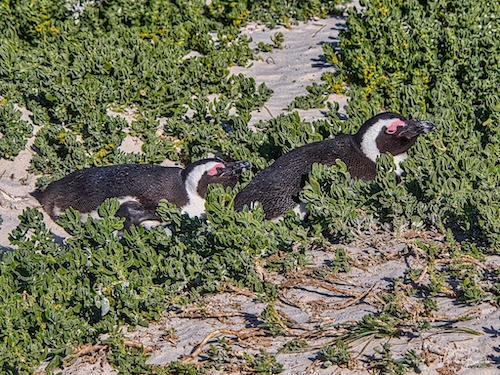
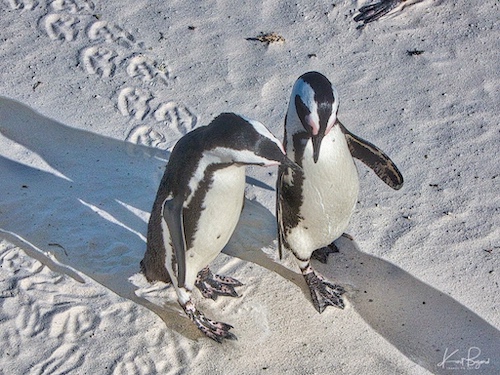
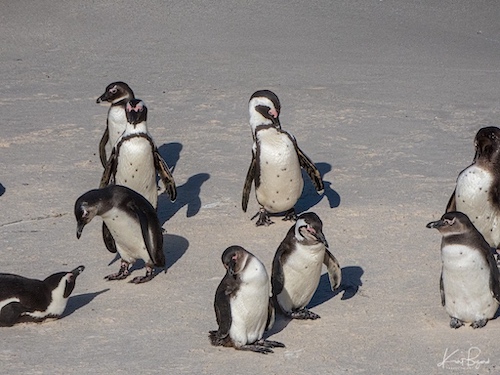
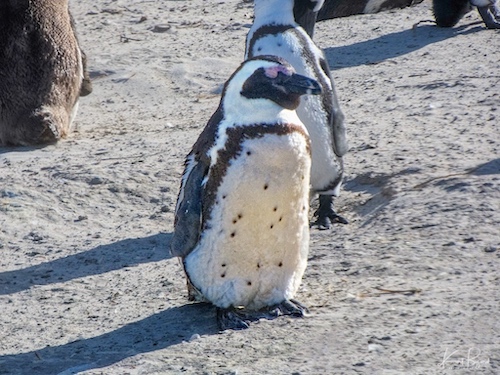
The African Penguin (Spheniscus demersus), also known as the Cape Penguin or South African Penguin, is a species of penguin confined to southern African waters. Like all extant penguins, it is flightless, with a streamlined body and wings stiffened and flattened into flippers for a marine habitat. Adults weigh an average of 4.9–7.7 lb (2.2–3.5 kg) and are 24–28 inches (60–70 cm) tall. The species has distinctive pink patches of skin above the eyes and a black facial mask. The body upperparts are black and sharply delineated from the white underparts, which are spotted and marked with a black band. The pink glands above their eyes help them with thermoregulation. To cope with changing temperatures, blood is sent to the glands to be cooled by the air. The African Penguin is only found on the south-western coast of Africa, living in colonies on 24 islands between Namibia and Algoa Bay, near Port Elizabeth, South Africa. It is the only penguin species that breeds in Africa, and its presence gave name to the Penguin Islands off the coast of Namibia.
Immature African Penguins
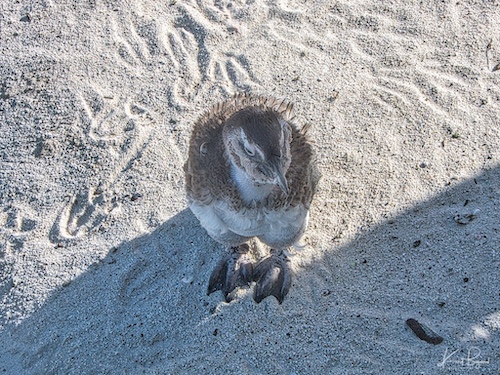
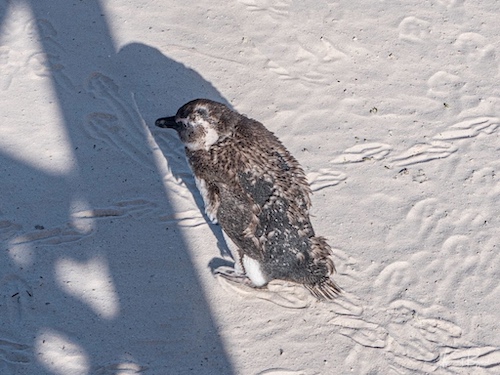
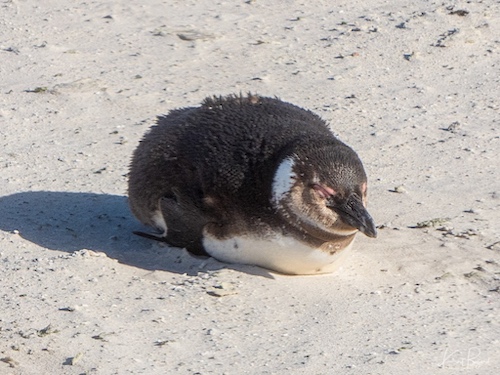
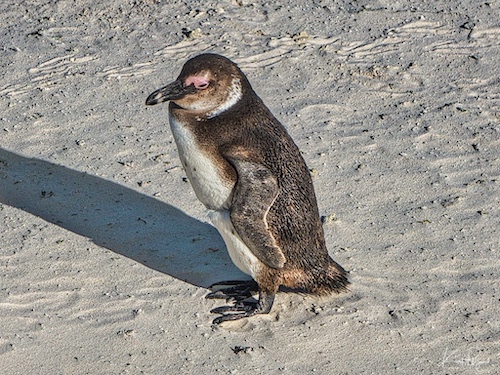
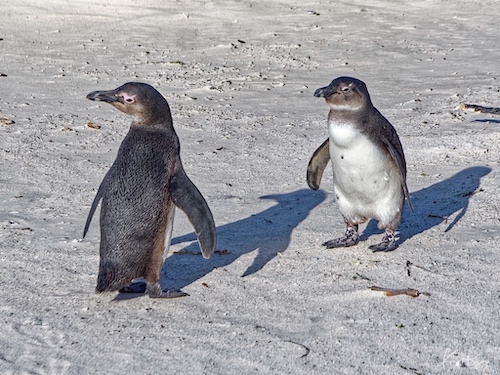
Juveniles do not possess the bold, delineated markings of the adult, but instead have dark upperparts that vary from greyish-blue to brown; the pale underparts lack both spots and the band. The African penguin is monogamous. It breeds in colonies, and pairs return to the same site each year. The African penguin has an extended breeding season, with nesting usually peaking from March to May in South Africa, and November to December in Namibia. A clutch of two eggs are laid either in burrows dug in guano, or scrapes in the sand under boulders or bushes. Incubation is undertaken equally by both parents for around 40 days. At least one parent guards the chicks for about one month, whereafter the chicks join a crèche (sort of like daycare for animals) with other chicks and both parents head out to sea to forage each day. Chicks fledge at 60 to 130 days, the timing depending on environmental factors such as the quality and availability of food. The fledged chicks then go to sea on their own, where they spend the next one to nearly two years. They then return to their natal colony to molt into adult plumage.
Related Banded Penguins
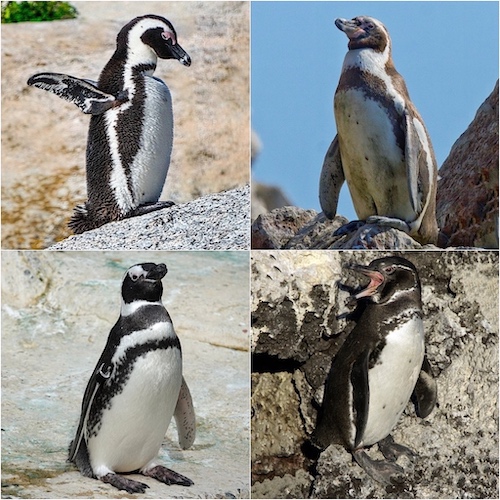
The banded penguins are penguins that belong to the genus Spheniscus. There are four living species of penguins known as banded penguins, and all have similar coloration. They are sometimes also known as “jack-ass penguins” due to their loud locator calls sounding similar to a donkey braying. Common traits include a band of black that runs around their bodies bordering their black dorsal coloring, black beaks with a small vertical white band, distinct spots on their bellies, and a small patch of unfeathered or thinly feathered skin around their eyes and underdeveloped fluff sack that can be either white or pink. All members of this genus lay eggs and raise their young in nests situated in burrows or natural depressions in the earth. The Humboldt penguin (Spheniscus humboldti) is a South American penguin living mainly in the Pingüino de Humboldt National Reserve in the North of Chile, although its habitat comprises most of coastal Chile and Peru. The Magellanic penguin is a South American penguin, breeding in coastal Patagonia, including Argentina, Chile and the Falkland Islands, with some migrating to Brazil where they are occasionally seen as far north as Espirito Santo. Lastly, the Galápagos penguin is a penguin endemic to the Galápagos Islands.
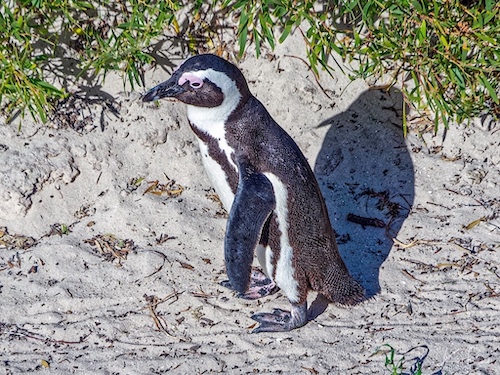
As always I hope you enjoyed the post and will return in the future for more.
[mappress mapid=”251″]
References:
Boulders Beach Lodge and Restaurant
Where did Cape Town’s African penguins come from, and why should we be worried?
Less than 8 years until African penguins are extinct: Here’s how YOU can prevent this

